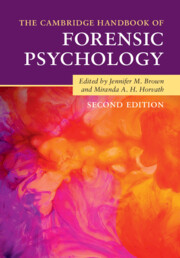Book contents
- The Cambridge Handbook of Forensic Psychology
- The Cambridge Handbook of Forensic Psychology
- Copyright page
- Dedication
- Contents
- Figures
- Tables
- Contributors
- Preface
- Forensic Psychology
- Part I Psychological Underpinnings
- Part II Psychology and Criminal Behaviour
- 2.1 Current Understandings of Sex-Based Harassment and Stalking Perpetration
- 2.2 The Behaviour of Sex Offenders
- 2.3 Intimate Partner Violence
- 2.4 Acquisitive Crime
- 2.5 Terrorism Research
- 2.6 Online Child Sexual Exploitation and Abuse
- 2.7 Arson
- 2.8 Serial Killings and Mass Murder
- Part III Assessment
- Part IV Interventions
- Part V Civil Proceedings
- Part VI Professional Practices
- Index
- References
2.6 - Online Child Sexual Exploitation and Abuse
from Part II - Psychology and Criminal Behaviour
Published online by Cambridge University Press: 02 December 2021
- The Cambridge Handbook of Forensic Psychology
- The Cambridge Handbook of Forensic Psychology
- Copyright page
- Dedication
- Contents
- Figures
- Tables
- Contributors
- Preface
- Forensic Psychology
- Part I Psychological Underpinnings
- Part II Psychology and Criminal Behaviour
- 2.1 Current Understandings of Sex-Based Harassment and Stalking Perpetration
- 2.2 The Behaviour of Sex Offenders
- 2.3 Intimate Partner Violence
- 2.4 Acquisitive Crime
- 2.5 Terrorism Research
- 2.6 Online Child Sexual Exploitation and Abuse
- 2.7 Arson
- 2.8 Serial Killings and Mass Murder
- Part III Assessment
- Part IV Interventions
- Part V Civil Proceedings
- Part VI Professional Practices
- Index
- References
Summary
For most people across the world the availability of the Internet and, in particular, hand-held devices, has had a positive impact on the way that people interact with the world and each other. However, this has also been associated with a number of cybercrimes and the focus of this chapter is online child sexual exploitation and abuse (OCSEA). These crimes include the production, preparation, consumption, sharing, dissemination or possession of CSEM and the solicitation of children for sexual purposes (sometimes called ‘grooming’), whether or not it results, or is intended to result, in a contact offence. It is difficult to make meaningful estimates of the scale of these crimes as conviction data is dependent on an individual being identified and the capacity of law enforcement to analyse the digital data associated with the crime. However, converging data would suggest that these crimes are increasing. OCSEA crimes may take place within a specific country but national and international cross-disciplinary collaboration is needed to both identify, locate and safeguard victims and prevent, investigate and prosecute these crimes. Europe is one region that has given greatest consideration to the issue of child exploitation and in particular child sexual abuse materials. In the last twenty years there has been considerable progress in understanding the demographic profiles of people who commit OCSEA crimes, what motivates them to offend and how they may be assessed in relation to future risks, particularly the commission of contact offences. However, it is unclear why our existing data would suggest that both identified OCSEA offenders and victims are more likely to be White rather than representing country-specific population demographics.
- Type
- Chapter
- Information
- The Cambridge Handbook of Forensic Psychology , pp. 279 - 295Publisher: Cambridge University PressPrint publication year: 2021
References
- 1
- Cited by

